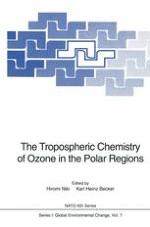1993 | OriginalPaper | Chapter
Sources of Organobromines to the Arctic Atmosphere
Authors : Robert Moore, Ryszard Tokarczyk, Charles Geen
Published in: The Tropospheric Chemistry of Ozone in the Polar Regions
Publisher: Springer Berlin Heidelberg
Included in: Professional Book Archive
Activate our intelligent search to find suitable subject content or patents.
Select sections of text to find matching patents with Artificial Intelligence. powered by
Select sections of text to find additional relevant content using AI-assisted search. powered by
Atmospheric measurements of bromine compounds were stimulated by the recognition that bromine was a potential catalyst in the destruction of ozone. In the course of these studies, it became apparent that bromoform (CHBr3) concentrations in the arctic atmosphere can be strongly seasonal; Cicerone et al. [1988] reported maxima at Point Barrow between December and February, and minima between June and August. Sturges and Barrie (1988) reported that atmospheric particulate Br peaked each year just after the Arctic dawn, with levels two orders of magnitude higher than could be explained by marine, automotive or crustal sources. Barrie et al. [1988] subsequently found that ozone depletion occurs in the arctic troposphere in springtime, and that ozone and filterable bromine concentrations were inversely correlated. These observations, together with the recent work of McConnell et al. [1992], have raised the question of the origin of arctic atmospheric bromine.
